Characterization of the Lower Cretaceous Shale in Lishu Fault Depression, Southeastern Songliao Basin: Implications for Shale Gas Resources Potential
Abstract
:1. Introduction
2. Geologic Settings
2.1. Strctural Belt and Stratigraphic Column
2.2. Stratigraphic Distribution and Lithology
3. Samples and Experiments
3.1. Samples
3.2. Organic Geochemical, Petrological and Helium Porosity Analysis
3.3. Field Emission Scanning Electron Microscopy (FE–SEM) Imaging Analysis
3.4. Low Pressure N2 Adsorption Measurement
3.5. CH4 Adsorption Measurement
3.6. Calculation of Absolute CH4 Adsorption
4. Results and Discussions
4.1. Organic Geochemistry and Mineral Compositions
4.2. FE-SEM Micrographs, Pore Types, and Helium Porosity
4.3. N2 Adsorption
4.4. CH4 Excess Adsorption
4.5. CH4 Adsorption Capacity Profiles with Depth
4.6. Evaluations of GIP: Implications for Shale Gas Resources
5. Conclusions
Author Contributions
Funding
Institutional Review Board Statement
Informed Consent Statement
Data Availability Statement
Conflicts of Interest
Abbreviation
| TOC | Total organic carbon content, %; |
| Ro | Vitrinite reflectance, %; |
| nexc | Excess adsorption amount, mg/g; |
| nabs | Absolute adsorption amount, mg/g; |
| Vads | Volume of adsorbed gas phase, cm3/g; |
| ρads | Density of adsorbed gas phase, mg/cm3; |
| ρg | Density of free gas phase, mg/cm3; |
| no | Maximum absolute methane adsorption capacity, mg/g; |
| P | Pressure, MPa; |
| PL | Langmuir pressure, MPa; |
| GIP | Gas-in-place, cm3/g rock under STP conditions; |
| nfree | Free gas storage capacity, cm3/g rock under STP conditions. |
References
- Dong, T.; He, S.; Yin, S.Y.; Wang, D.X.; Hou, Y.G.; Guo, J.G. Geochemical characterization of source rocks and crude oils in the upper Cretaceous Qingshankou formation, Changling sag, southern Songliao Basin. Mar. Petrol. Geol. 2015, 64, 173–188. [Google Scholar] [CrossRef]
- Xu, J.J.; Liu, Z.J.; Bechtel, A.; Sachsenhofer, R.F.; Jia, J.J.; Meng, Q.T.; Sun, P.C. Organic matter accumulation in the upper cretaceous Qingshankou and Nenjiang formations, Songliao Basin (NE China): Implications from high–resolution geochemical analysis. Mar. Petrol. Geol. 2019, 102, 187–201. [Google Scholar] [CrossRef]
- Yang, X.; Wang, H.; Li, Z.; Guan, C.; Wang, X. Tectonic–sedimentary evolution of a continental rift basin: A case study of the Early Cretaceous Changling and Lishu Fault Depressions, southern Songliao Basin, China. Mar. Petrol. Geol. 2021, 128, 105068. [Google Scholar] [CrossRef]
- Zhang, M.; Li, H.B.; Wang, X. Geochemical characteristics and grouping of the crude oils in the Lishu Fault Depression, Songliao basin, NE China. J. Petrol. Sci. Eng. 2013, 110, 32–39. [Google Scholar] [CrossRef]
- Tang, Y.; Yang, R.; Zhu, J.; Yin, S.; Fan, T.; Dong, L.; Hou, Y. Analysis of continental shale gas accumulation conditions in a rifted basin: A case study of Lower Cretaceous shale in the southern Songliao Basin, northeastern China. Mar. Petrol. Geol. 2019, 101, 389–409. [Google Scholar] [CrossRef]
- Zhou, N.; Lu, S.; Zhang, P.; Wang, M.; Xiao, D.; Li, J.; Chen, G.; Wang, J.; Zhang, Y.; Lin, Z. Continental shale gas dynamic enrichment and evolution over geological time. Int. J. Coal Geol. 2021, 251, 103914. [Google Scholar] [CrossRef]
- Song, Z.; Li, Z.; Zhang, X.; Zhou, Z.; Yang, H. Characteristics of shale gas reservoirs and evaluation of their gas potential in Sujiatun area, Lishu Fault Depression, Songliao Basin. Petrol. Geol. Exp. 2015, 37, 606–613, (In Chinese with English Abstract). [Google Scholar] [CrossRef]
- GB/T 31483–2015; PRC National Standard: Geological Evaluation Methods for Shale Gas. China Quality and Standards Publishing & Media Co., Ltd.: Beijing, China, 2015. (In Chinese)
- Curtis, J.B. Fractured shale-gas systems. AAPG Bull. 2002, 86, 1921–1938. [Google Scholar] [CrossRef]
- Hao, F.; Zou, H. Cause of shale gas geochemical anomalies and mechanisms for gas enrichment and depletion in high-maturity shales. Mar. Petrol. Geol. 2013, 44, 1–12. [Google Scholar] [CrossRef]
- Li, W.; Li, J.; Lu, S.; Chen, G.; Pang, X.; Zhang, P.; He, T. Evaluation of gas-in-place content and gas-adsorbed ratio using carbon isotope fractionation model: A case study from Longmaxi shales in Sichuan Basin, China. Int. J. Coal Geol. 2022, 249, 103881. [Google Scholar] [CrossRef]
- Wei, S.; He, S.; Hu, M.; Yang, W.; Guo, X.; Iglauer, S.; Zhai, G. Supercritical high–pressure methane adsorption on the lower Cambrian Shuijingtuo shale in the Huangling anticline area, south China: Adsorption behavior, storage characteristics, and geological implications. Energy Fuels 2021, 35, 19973–19985. [Google Scholar] [CrossRef]
- Ross, D.J.K.; Bustin, R.M. The importance of shale composition and pore structure upon gas storage potential of shale gas reservoirs. Mar. Petrol. Geol. 2009, 26, 916–927. [Google Scholar] [CrossRef]
- Tian, H.; Li, T.; Zhang, T.; Xiao, X. Characterization of methane adsorption on overmature Lower Silurian–Upper Ordovician shales in Sichuan Basin, southwest China: Experimental results and geological implications. Int. J. Coal Geol. 2016, 156, 36–49. [Google Scholar] [CrossRef]
- Rani, S.; Padmanabhan, E.; Prusty, B.K. Review of gas adsorption in shales for enhanced methane recovery and CO2 storage. J. Petrol. Sci. Eng. 2019, 175, 634–643. [Google Scholar] [CrossRef]
- Lewis, R.; Ingraham, D.; Pearcy, M.; Williamson, J.; Sawyer, W.; Frantz, J. New Evaluation Techniques for Gas Shale Resezrvoirs. 2004. Available online: http://citeseerx.ist.psu.edu/viewdoc/download?doi=10.1.1.455.2453&rep=rep1&type=pdf (accessed on 18 April 2022).
- Tang, Y.; Li, L.; Jiang, S. A logging interpretation methodology of gas content in shale reservoirs and its application. Nat. Gas Ind. 2014, 34, 46–54, (In Chinese with English Abstract). [Google Scholar] [CrossRef]
- Tang, X.; Ripepi, N.; Stadie, N.P.; Yu, L.; Hall, M.R. A dual-site Langmuir equation for accurate estimation of high pressure deep shale gas resources. Fuel 2016, 185, 10–17. [Google Scholar] [CrossRef] [Green Version]
- Chen, L.; Liu, K.; Jiang, S.; Huang, H.; Tan, J.; Zuo, L. Effect of adsorbed phase density on the correction of methane excess adsorption to absolute adsorption in shale. Chem. Eng. J. 2021, 420, 127678. [Google Scholar] [CrossRef]
- Liu, F.; Cheng, R.; Xie, Q.; Hu, W.; Tang, J.; Li, Z.; Yang, X.; Xu, H.; Zhou, L. The potential evaluation of shale gas resources of Lishu Fault Depression in Songliao basin. J. Jilin Univ. Earth Sci. Ed. 2014, 44, 762–773, (In Chinese with English Abstract). [Google Scholar] [CrossRef]
- GB/T 19145–2003; PRC National Standard: Determination of Total Organic Carbon in Sedimentary Rock. China Quality and Standards Publishing & Media Co., Ltd.: Beijing, China, 2003. (In Chinese)
- ASTM D7708–14; Standard Test Method for Microscopical Determination of the Reflectance of Vitrinite Dispersed in Sedimentary Rocks. ASTM International: West Conshohocken, PA, USA, 2014. [CrossRef]
- Xu, H.; Xie, Q.; Wang, S.; Yu, S. Organic geochemical characteristics and gas prospectivity of Permian source rocks in western margin of Songliao Basin, northeastern China. J. Petrol. Sci. Eng. 2021, 205, 108863. [Google Scholar] [CrossRef]
- SY/T 5163–2018; PRC Oil and Gas Industry Standard: Analysis Method for Clay Minerals and Ordinary Non–Clay Minerals in Sedimentary Rocks by the X-ray Diffraction. China National Energy Administration: Beijing, China, 2018. (In Chinese)
- SY/T 6385–2016; PRC Oil and Gas Industry Standard: Porosity and Permeability Measurement under Overburden Pressure. China National Energy Administration: Beijing, China, 2016. (In Chinese)
- Loucks, R.G.; Reed, R.M.; Ruppel, S.C.; Hammes, U. Spectrum of pore types and networks in mudrocks and a descriptive classification for matrix–related mudrock pores. AAPG Bull. 2012, 96, 1071–1098. [Google Scholar] [CrossRef] [Green Version]
- GB/T 21650.2–2008; PRC National Standard: Pore Size Distribution and Porosity of Solid Materials by Mercury Porosimetry and Gas Adsorption–Part 2: Analysis of Mesopores and Macropores by Gas Adsorption. China Quality and Standards Publishing & Media Co., Ltd.: Beijing, China, 2008. (In Chinese)
- Brunauer, S.; Emmett, P.; Teller, E. Adsorption of gases in multimolecular layers. J. Am. Chem. Soc. 1938, 60, 309–319. [Google Scholar] [CrossRef]
- Barrett, E.P.; Joyner, L.G.; Halenda, P.P. The determination of pore volume and area distributions in porous substances. I. Computations from nitrogen isotherms. J. Am. Chem. Soc. 1951, 73, 373–380. [Google Scholar] [CrossRef]
- Geerlings, P.; De Proft, F.; Langenaeker, W. Conceptual density functional theory. Chem. Rev. 2003, 103, 1793–1874. [Google Scholar] [CrossRef] [PubMed]
- Setzmann, U.; Wagner, W. A new equation of state and tables of thermodynamic properties for methane covering the range from the melting line to 625 K at pressures up to 100 MPa. J. Phys. Chem. Ref. Data 1991, 20, 1061–1155. [Google Scholar] [CrossRef] [Green Version]
- Keller, J.U.; Staudt, R. Gas Adsorption Equilibria: Experimental Methods and Adsorptive Isotherms; Springer Science & Business Media, Inc.: New York, NY, USA, 2005. [Google Scholar]
- Langmuir, I. The adsorption of gases on plane surfaces of glass, mica and platinum. J. Am. Chem. Soc. 1918, 40, 1361–1403. [Google Scholar] [CrossRef] [Green Version]
- Thyberg, B.; Jahren, J. Quartz cementation in mudstones: Sheet-like quartz cement from clay mineral reactions during burial. Petrol. Geosci. 2011, 17, 53–63. [Google Scholar] [CrossRef]
- De Silva, P.N.K.; Simons, S.J.R.; Stevens, P.; Philip, L.M. A comparison of North American shale plays with emerging non-marine shale plays in Australia. Mar. Pet. Geol. 2015, 67, 16–29. [Google Scholar] [CrossRef] [Green Version]
- Chalmers, G.R.; Ross, D.J.; Bustin, R.M. Geological controls on matrix permeability of Devonian gas shales in the Horn River and Liard basins, northeastern British Columbia, Canada. Int. J. Coal Geol. 2012, 103, 120–131. [Google Scholar] [CrossRef]
- Chalmers, G.R.; Bustin, R.M.; Power, I.M. Characterization of gas shale pore systems by porosimetry, pycnometry, surface area, and field emission scanning electron microscopy/transmission electron microscopy image analyses: Examples from the Barnett, Woodford, Haynesville, Marcellus, and Doig units. AAPG Bull. 2012, 96, 1099–1119. [Google Scholar] [CrossRef]
- Wang, M.; Xue, H.T.; Tian, S.S.; Wilkins, R.W.T.; Wang, Z.W. Fractal characteristics of upper cretaceous lacustrine shale from the Songliao Basin, NE China. Mar. Petrol. Geol. 2015, 67, 144–153. [Google Scholar] [CrossRef]
- Tian, H.; Pan, L.; Zhang, T.; Xiao, X.; Meng, Z.; Huang, B. Pore characterization of organic-rich lower Cambrian shales in Qiannan depression of Guizhou province, Southwestern China. Mar. Petrol. Geol. 2015, 62, 28–43. [Google Scholar] [CrossRef]
- Wang, Y.; Zhu, Y.; Chen, S.; Li, W. Characteristics of the nanoscale pore structure in Northwestern Hunan shale gas reservoirs using field emission scanning electron microscopy, high-pressure mercury intrusion, and gas adsorption. Energy Fuels 2014, 28, 945–955. [Google Scholar] [CrossRef]
- Curtis, M.E.; Cardott, B.J.; Sondergeld, C.H.; Rai, C.S. Development of organic porosity in the Woodford Shale with increasing thermal maturity. Int. J. Coal Geol. 2012, 103, 26–31. [Google Scholar] [CrossRef]
- Ambrose, R.J.; Hartman, R.C.; Diaz-Campos, M.; Akkutlu, I.Y.; Sondergeld, C.H. New Pore–Scale Considerations for Shale Gas in Place Calculations; Society of Petroleum Engineers: Houston, TX, USA, 2010. [Google Scholar] [CrossRef]
- Sing, K.S.W.; Everett, D.H.; Haul, R.A.W.; Moscou, L.; Pierotti, R.A.; Rouquerol, J.; Siemieniewska, T. Reporting physisorption data for gas/solid systems with special reference to the determination of surface area and porosity. Pure Appl. Chem. 1985, 57, 603–619. [Google Scholar] [CrossRef]
- King, H.E., Jr.; Eberle, A.P.; Walters, C.C.; Kliewer, C.E.; Ertas, D.; Huynh, C. Pore architecture and connectivity in gas shale. Energy Fuels 2015, 29, 1375–1390. [Google Scholar] [CrossRef]
- Li, H.; Liu, D.; Peng, P.; Wang, Q. Tectonic impact on reservoir character of Chongqing and its neighbor area. Nat. Gas Geosci. 2015, 26, 1705–1711. [Google Scholar] [CrossRef]
- Do, D.D.; Do, H.D. Pore characterization of carbonaceous materials by DFT and GCMC simulations: A review. Adsorpt. Sci. Technol. 2003, 21, 389–423. [Google Scholar] [CrossRef]
- Yang, F.; Ning, Z.; Zhang, R.; Zhao, H.; Krooss, B.M. Investigations on the methane sorption capacity of marine shales from Sichuan Basin, China. Int. J. Coal Geol. 2015, 146, 104–117. [Google Scholar] [CrossRef]
- Liang, L.; Luo, D.; Liu, X.; Xiong, J. Experimental study on the wettability and adsorption characteristics of Longmaxi Formation shale in the Sichuan Basin, China. J. Nat. Gas Sci. Eng. 2016, 33, 1107–1118. [Google Scholar] [CrossRef]
- Pan, L.; Xiao, X.; Tian, H.; Zhou, Q.; Cheng, P. Geological models of gas in place of the Longmaxi shale in southeast Chongqing, south China. Mar. Petrol. Geol. 2016, 73, 433–444. [Google Scholar] [CrossRef]
- Hao, F.; Zou, H.; Lu, Y. Mechanisms of shale gas storage: Implications for shale gas exploration in China. AAPG Bull. 2013, 97, 1325–1346. [Google Scholar] [CrossRef]
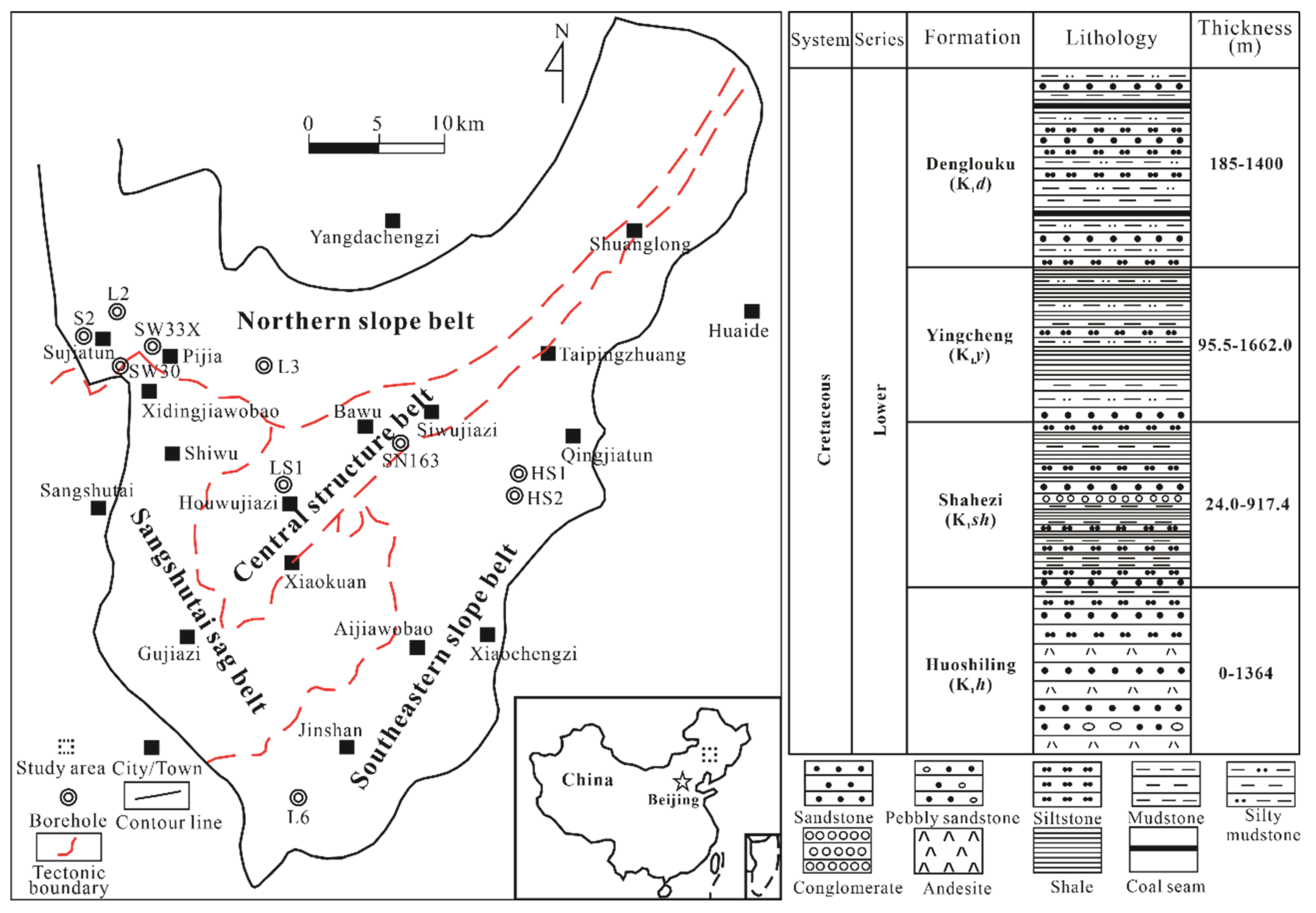
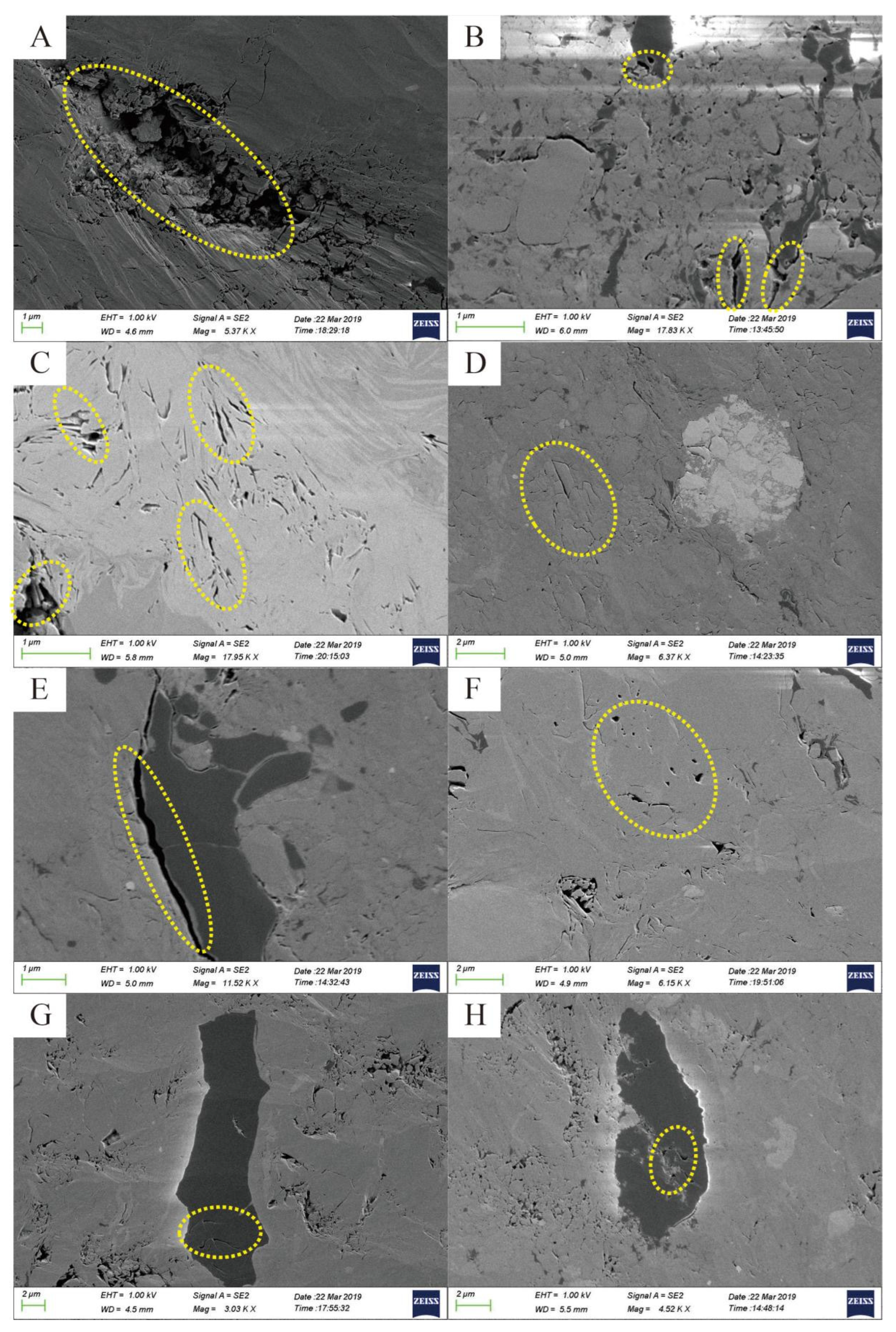
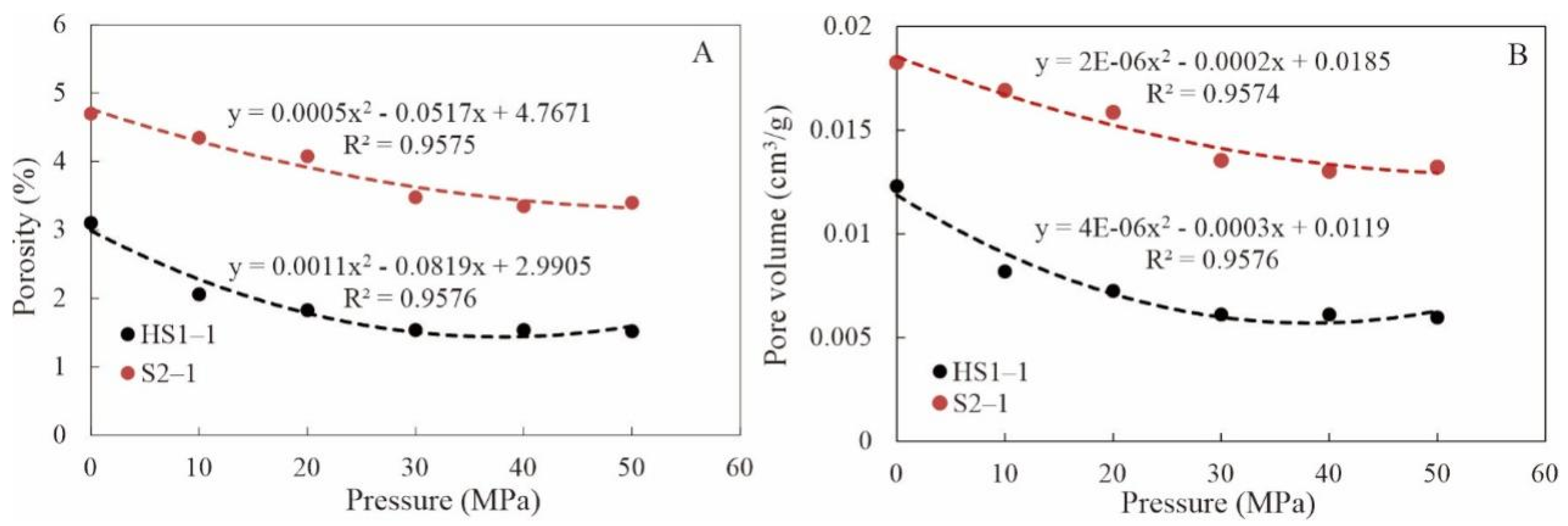
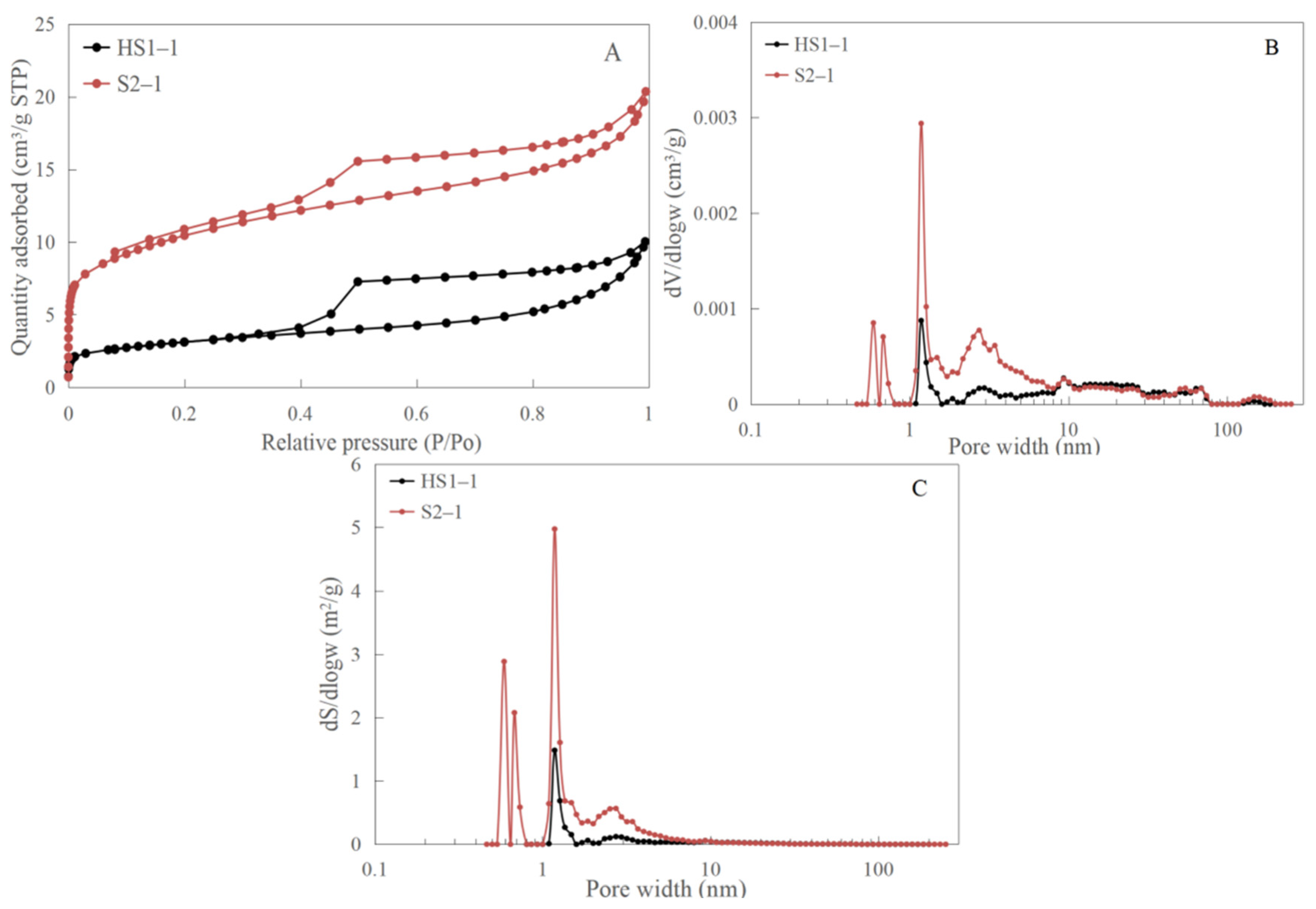
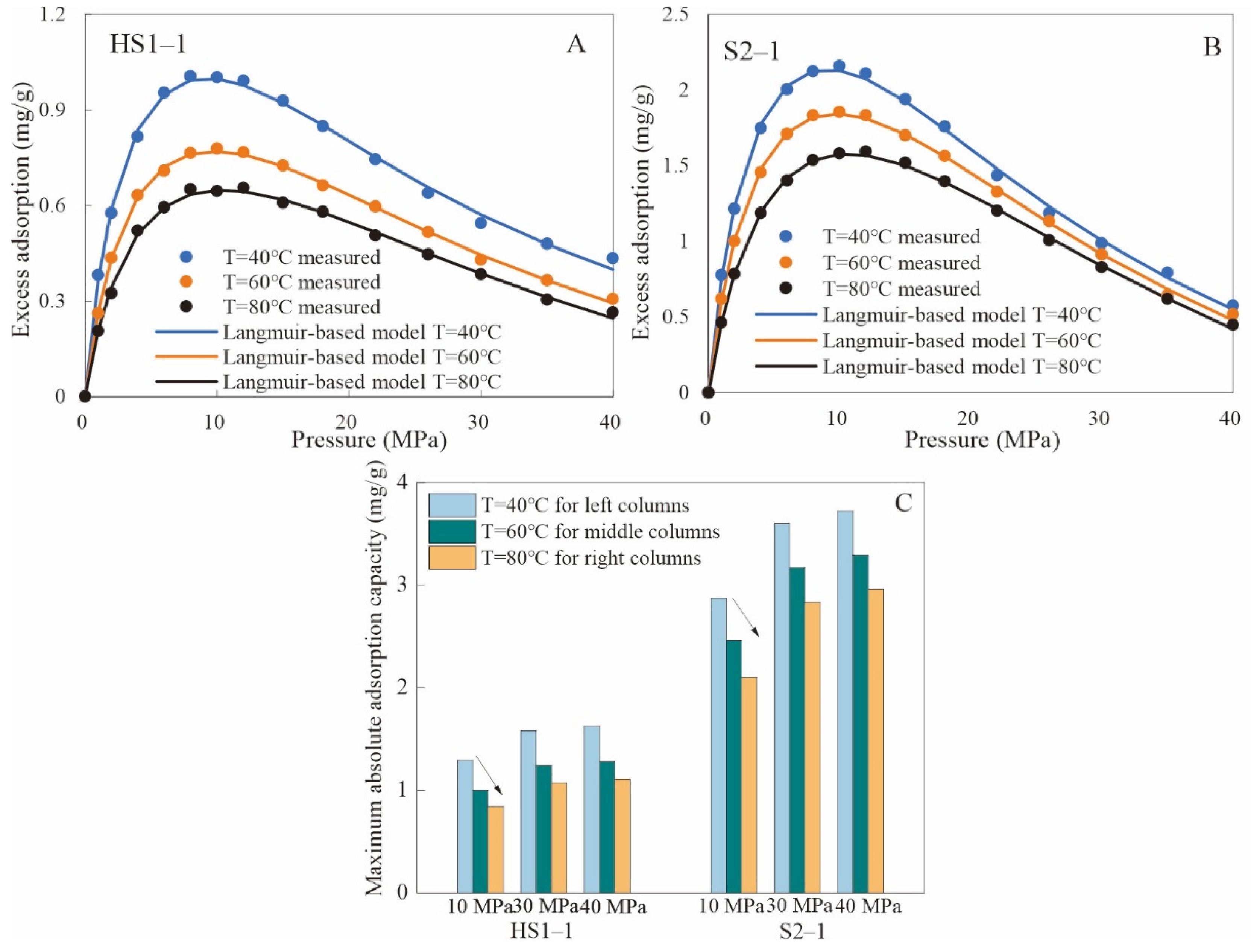
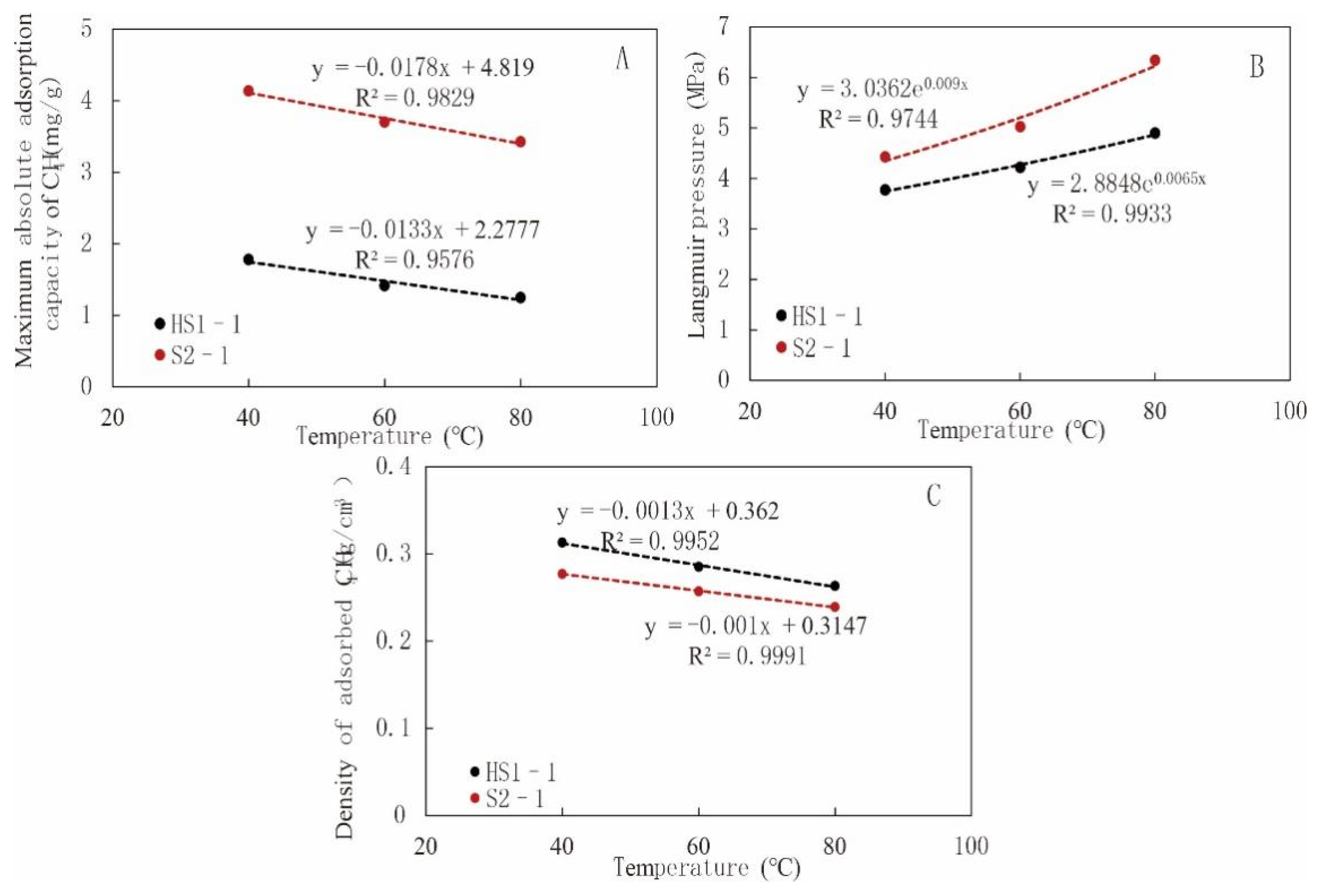
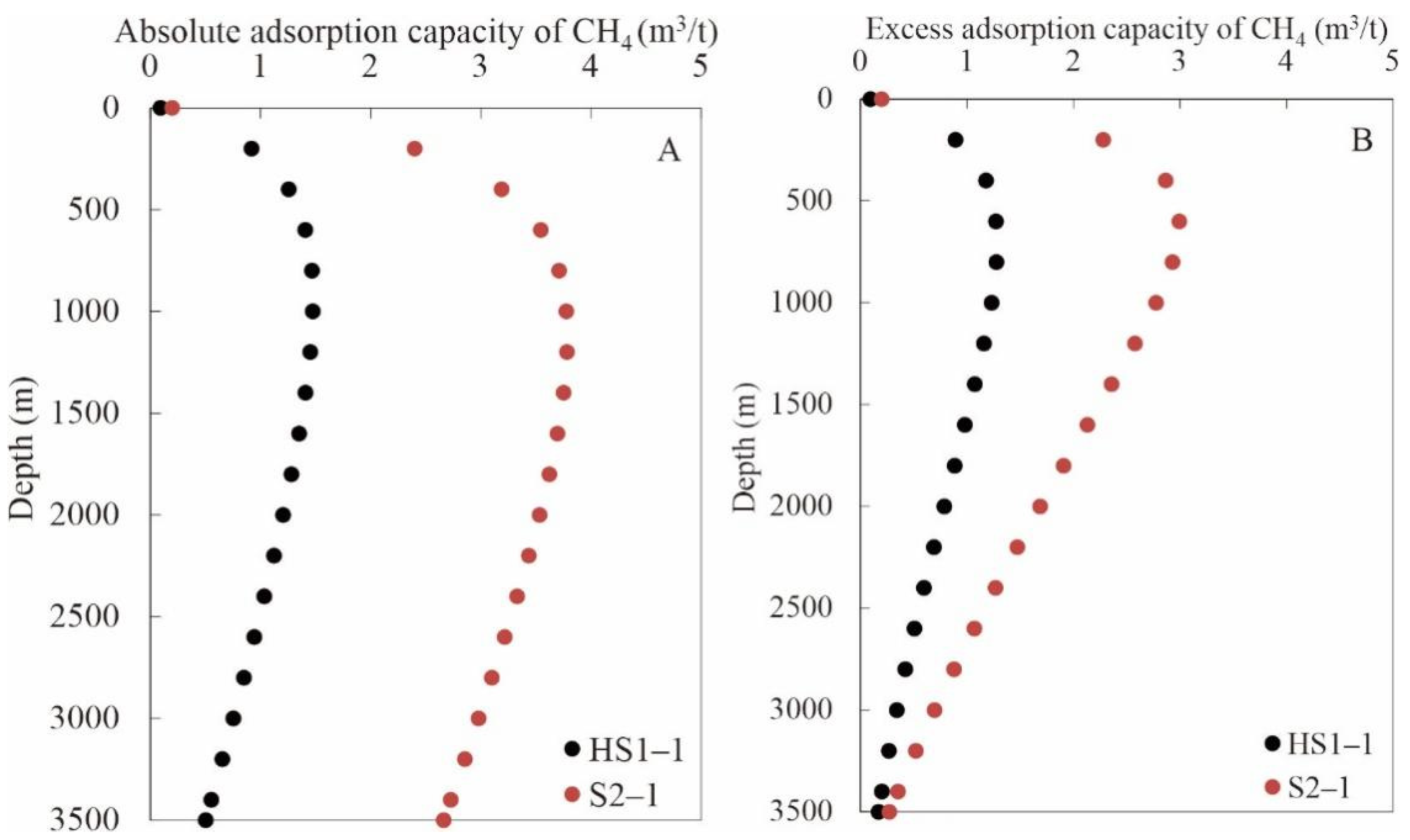
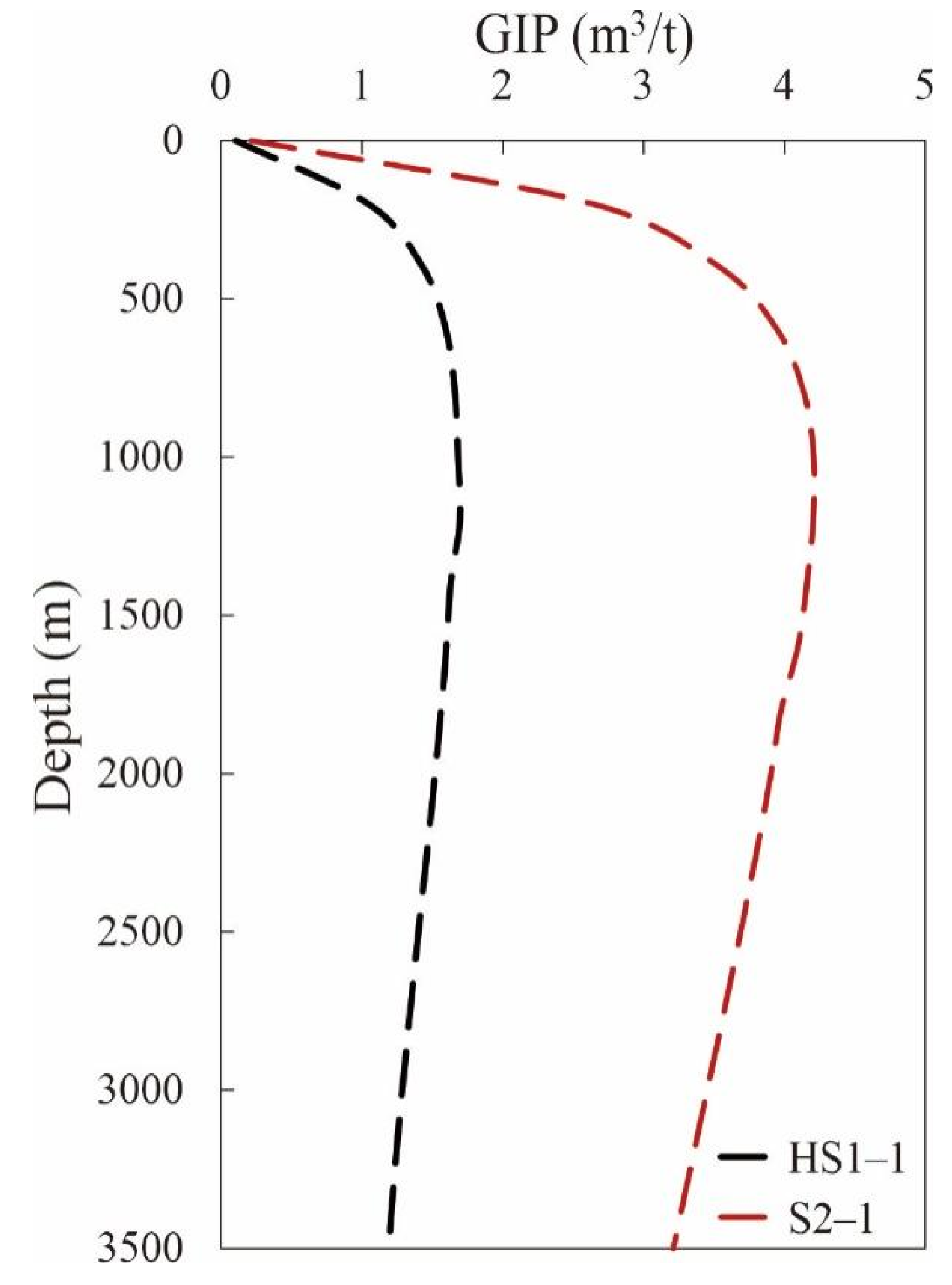
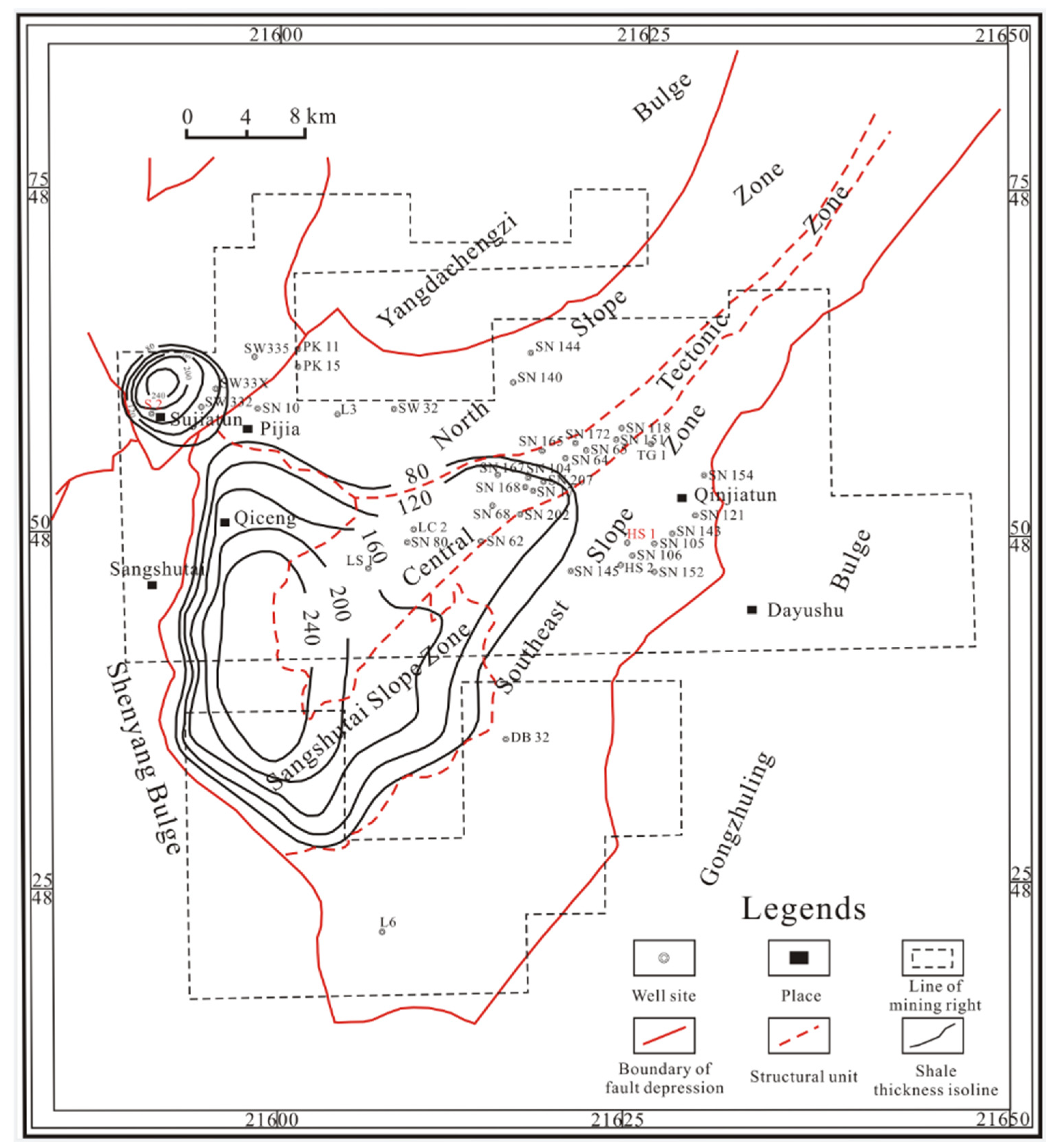
| Sample | Ro (%) | TOC (%) | Mineral Composition (%) | ||||||||
|---|---|---|---|---|---|---|---|---|---|---|---|
| Quartz | Feldspar | Calcite | Dolomite | Pyrite | Clay | Illite | I/S | Chlorite | |||
| HS1–1 | 1.6 | 2.01 | 36.7 | 14.0 | 1.2 | 1.0 | 2.8 | 44.3 | 31.9 | 5.4 | 7.0 |
| S2–1 | 2.1 | 2.45 | 38.6 | 7.4 | 3.8 | 2.3 | 3.1 | 44.8 | 30.6 | 5.1 | 9.1 |
| Sample | SBET (m2/g) | VBJH (cm3/g) | VDA (cm3/g) | DBJH (nm) | PMi (%) | PMe (%) | PMa (%) |
|---|---|---|---|---|---|---|---|
| HS1–1 | 10.558 | 0.0145 | 0.0053 | 6.989 | 25.89 | 66.36 | 7.75 |
| S2–1 | 35.139 | 0.0266 | 0.0144 | 4.314 | 43.39 | 51.88 | 4.73 |
| Sample | Temperature (°C) | Excess Adsorbed Amounts of CH4 (mg/g) | ||||||||||||||
|---|---|---|---|---|---|---|---|---|---|---|---|---|---|---|---|---|
| 0 MPa | 1 MPa | 2 MPa | 4 MPa | 6 MPa | 8 MPa | 10 MPa | 12 MPa | 15 MPa | 18 MPa | 22 MPa | 26 MPa | 30 MPa | 35 MPa | 40 MPa | ||
| HS1–1 | 40 | 0 | 0.38 | 0.58 | 0.82 | 0.95 | 1.01 | 1.00 | 0.99 | 0.93 | 0.85 | 0.74 | 0.64 | 0.54 | 0.48 | 0.43 |
| 60 | 0 | 0.26 | 0.44 | 0.63 | 0.71 | 0.76 | 0.78 | 0.77 | 0.73 | 0.66 | 0.60 | 0.52 | 0.43 | 0.36 | 0.31 | |
| 80 | 0 | 0.21 | 0.32 | 0.52 | 0.59 | 0.65 | 0.64 | 0.66 | 0.61 | 0.58 | 0.51 | 0.45 | 0.38 | 0.30 | 0.26 | |
| S2–1 | 40 | 0 | 0.78 | 1.21 | 1.75 | 2.01 | 2.12 | 2.16 | 2.11 | 1.94 | 1.76 | 1.44 | 1.19 | 0.99 | 0.79 | 0.58 |
| 60 | 0 | 0.62 | 1.00 | 1.46 | 1.71 | 1.83 | 1.85 | 1.83 | 1.70 | 1.56 | 1.33 | 1.13 | 0.91 | 0.64 | 0.52 | |
| 80 | 0 | 0.46 | 0.78 | 1.19 | 1.40 | 1.54 | 1.58 | 1.59 | 1.52 | 1.40 | 1.20 | 1.01 | 0.83 | 0.62 | 0.45 | |
| Sample | |||||||||
|---|---|---|---|---|---|---|---|---|---|
| 40 | 60 | 80 | 40 | 60 | 80 | 40 | 60 | 80 | |
| HS1–1 | 1.78 | 1.42 | 1.25 | 3.77 | 4.22 | 4.90 | 0.31 | 0.29 | 0.26 |
| S2–1 | 4.14 | 3.70 | 3.43 | 4.43 | 5.02 | 6.34 | 0.28 | 0.26 | 0.24 |
Publisher’s Note: MDPI stays neutral with regard to jurisdictional claims in published maps and institutional affiliations. |
© 2022 by the authors. Licensee MDPI, Basel, Switzerland. This article is an open access article distributed under the terms and conditions of the Creative Commons Attribution (CC BY) license (https://creativecommons.org/licenses/by/4.0/).
Share and Cite
Xie, Q.; Xu, H.; Yu, S. Characterization of the Lower Cretaceous Shale in Lishu Fault Depression, Southeastern Songliao Basin: Implications for Shale Gas Resources Potential. Energies 2022, 15, 5156. https://doi.org/10.3390/en15145156
Xie Q, Xu H, Yu S. Characterization of the Lower Cretaceous Shale in Lishu Fault Depression, Southeastern Songliao Basin: Implications for Shale Gas Resources Potential. Energies. 2022; 15(14):5156. https://doi.org/10.3390/en15145156
Chicago/Turabian StyleXie, Qilai, Hao Xu, and Shuang Yu. 2022. "Characterization of the Lower Cretaceous Shale in Lishu Fault Depression, Southeastern Songliao Basin: Implications for Shale Gas Resources Potential" Energies 15, no. 14: 5156. https://doi.org/10.3390/en15145156
APA StyleXie, Q., Xu, H., & Yu, S. (2022). Characterization of the Lower Cretaceous Shale in Lishu Fault Depression, Southeastern Songliao Basin: Implications for Shale Gas Resources Potential. Energies, 15(14), 5156. https://doi.org/10.3390/en15145156






